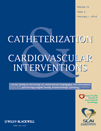Amplatzer septal occluder to treat iatrogenic cardiac perforations†
Conflict of interest: BM has received research grants and speaker fees from AGA-St. Jude Medical.
Abstract
Background: Iatrogenic free wall cardiac perforation is a rare but serious complication encountered during percutaneous cardiac procedures, which usually leads to tamponade and death. Septal occluder devices have been developed for sealing intracardiac shunts but may be also used in this emergency setting. Methods and Results: We report a small series of five consecutive cases of iatrogenic heart perforations that were treated with implantation of Amplatzer Septal Occluders (ASO). In the first case, iatrogenic left ventricle (LV) perforation occurred during LV biopsy and could be closed up with a 4 mm ASO. In the second case, a 4 mm ASO was used for sealing of a right atrial perforation allocated to Port-a-Cath dislodgment. The third case happened during transseptal puncture for implantation of a TandemHeart bVAD device in a patient suffering cardiogenic shock and was treated by implantation of a 5 mm ASO. The fourth patient was transferred to our facilities for percutaneous closure of an acute post-infarct VSD after anteroseptal myocardial infarction. This procedure was complicated by perforation of the posterolateral free wall and led to the deployment of 12 mm ASO. The last patient suffered from free LV wall perforation during investigation of a severe aortic stenosis and was treated by implantation of 4 mm ASO. All patients were alive after 24 hrs but the last patient died during the in-hospital stay of a right ventricular infarction complicated by multiple organ failure. Conclusions: Percutaneous device occlusion of iatrogenic heart perforation seems to be a safe and efficient method to treat iatrogenic heart perforation. In order to perform this elegant method, it is however imperative not to prematurely withdraw the perforating catheter to maintain access to the hole for closure. © 2011 Wiley Periodicals, Inc.




